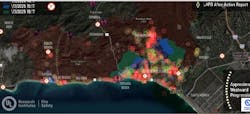Timelines of Historic CA Wildfires Determined by UL Fire Safety Researchers
“Our report represents a critical first step in understanding how the Southern California fires last January progressed — and how agencies responded during this unprecedented event. Documenting these preparedness measures and response activities across 12 simultaneous fires is essential for strengthening our defenses against wildfires that interface with the built environment.”
Releasing the Southern California Fires Timeline Report Thursday, Fire Safety Research Institute Vice President and Executive Director Steve Kerber added: “Our hearts are with the people of California. And while we recognize the profound impact these fires have had, our research into WUI fires takes greater urgency and purpose. By studying this incident and learning from it, we can help to reduce the impact of WUI fires and better protect communities in the future.”
"The two (2) most destructive fires, the Palisades and Eaton Fires, each taking 12 and 19 lives respectively, resulted in major conflagrations, with still-preliminary estimates exceeding $100 billion in property losses."
CA Gov. Gavin Newsom requested UL researchers to compile the comprehensive analysis of the historic blazes.
Investigators took a look at the agencies responsible for prevention, preparedness, and response, as well as the organizations responsible for maintaining the area’s infrastructure such as electrical, water, communications, and transportation networks.
After months of research and interviews, investigators wrote: "Comparing the fire progression and response timelines, it appears that the responding fire and
emergency service agencies in this area of Southern California were overwhelmed by the number of concurrent fires; the fires’ severity; the rapid, winddriven fire spread through the built environment; and the resulting resource limitations.
"Despite agencies taking critical steps to prepare for the severe fire weather that was forecasted well in advance of early January 2025, having access to a response system that provides extensive fire suppression resources drawn from multiple agencies, and deploying one of the largest initial attack responses to date in the United States, Southern California experienced massive loss of life and property."
Researchers who listened to hours of radio communications also used AI as they investigated the progression. Images and videos taken by civilians, the media and fire officials also were used during the probe.
The timeline begins just prior to the start of the Palisades Fire on Jan, 7 at 10:30 a.m. PST and ends when fire progression through the built environment lessened and when sufficient resources were available to address the existing threat for both fires on the morning of Jan. 8.
Authors explained that this phase of the report does not "include an analysis of recovery efforts or the fires’ cause and origin investigations, which are being conducted by the jurisdictional fire departments with assistance from federal and state agencies and private contractors."
FSRI Research Program Manager Derek Alkonis explained: "To develop a comprehensive timeline, it is essential to conduct interviews with personnel from fire service and law enforcement agencies, as well as professionals working in prevention and preparedness roles. This represents a significant operational undertaking requiring coordination across multiple agencies and stakeholders."
Among the findings:
- A National Weather Service warning prompted upstaffing at federal, state, and local governments, as well as private suppression organizations. Many agencies prepositioned resources in the Los Angeles region to enhance response readiness. This massive response would ultimately be overmatched by the extreme fire behavior experienced during both the Palisades and Eaton Fires. Law enforcement agencies and fire departments, as well as community brigades and private responders, worked alongside each other to evacuate residents and prepare areas for fire impact as fallen trees, utility poles, and wires blocked roads.
- Fire department personnel who engaged in structure defense throughout the Palisades and Eaton Fire areas faced significant challenges, including limited visibility and grounded aircraft due to dangerous wind conditions. As structures burned and water distribution systems were damaged or destroyed, water spewed freely from pipes, draining water supplies and diminishing fire hydrant pressure.
Officials also noted they did not attempt to determine a cause for the fires as other agencies are investigating.
The second report, still being compiled, will be an analysis to "understand pre-existing conditions in the fire areas, the influence of the built environment on fire behavior, first responders’ actions, and emergency response agencies’ capabilities for addressing urban conflagrations."
Based on their findings, they will make detailed recommendations to improve emergency preparedness and response.
About the Author
Susan Nicol
News Editor
Susan Nicol is the news editor for Firehouse.com. She is a life member and active with the Brunswick Volunteer Ambulance & Rescue Company, Oxford Fire Company and Brunswick Vol. Fire Co. Susie has been an EMT in Maryland since 1976. Susie is vice-president of the Frederick County Fire/Rescue Museum. She is on the executive committee of Frederick County Volunteer Fire and Rescue Association. She also is part of the Maryland Institute for Emergency Medical Services Systems (MIEMSS) Region II EMS Council. Susie is a board member of the American Trauma Society, Maryland Division. Prior to joining the Firehouse team, she was a staff writer for The Frederick News-Post, covering fire, law enforcement, court and legislative issues.

